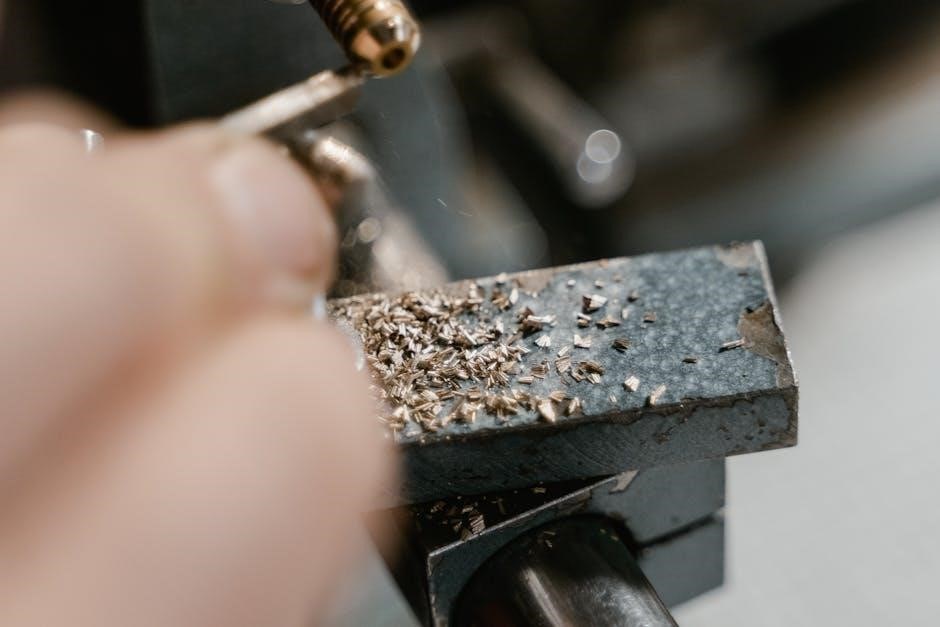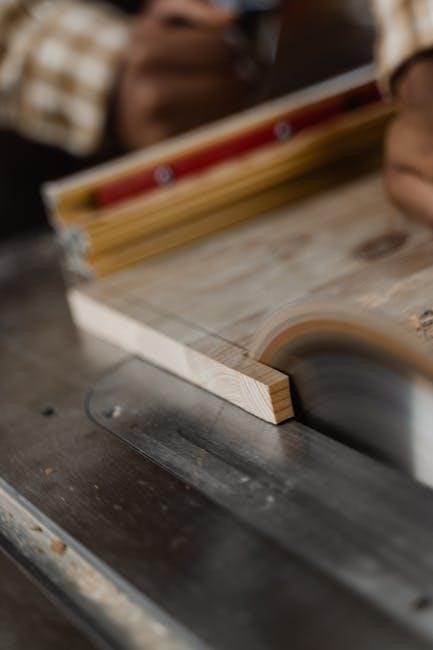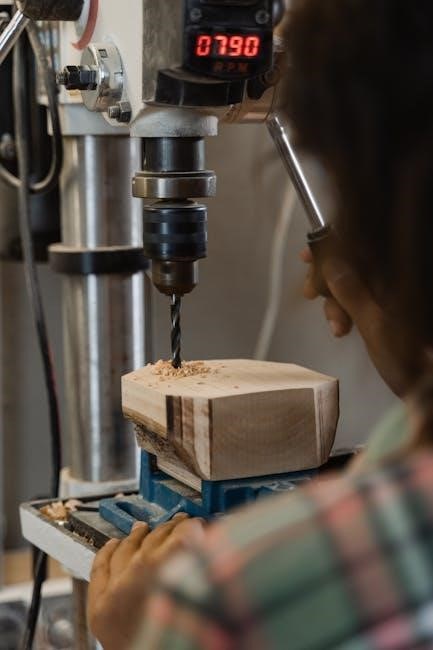1.1 What is a Precision Drill Guide?
A precision drill guide is a versatile tool designed to enhance drilling accuracy, ensuring straight and angled holes with ease. It attaches to power drills for precise control.
A precision drill guide is a versatile tool designed to enhance drilling accuracy, ensuring straight and angled holes. It attaches to power drills, offering adjustable angles, V-guides for alignment, and compatibility with various drill sizes. Ideal for woodworking, metalworking, and DIY projects, it provides precise control, making it essential for professionals and hobbyists seeking consistent results in their drilling tasks.
1.2 Importance of Precision in Drilling
Precision in drilling is crucial for achieving accurate, consistent results. It prevents errors, enhances safety, and ensures projects meet professional standards. Whether for woodworking, metalworking, or DIY tasks, precise drilling maintains structural integrity, avoids material waste, and delivers professional-grade outcomes. This level of accuracy is essential for both professional applications and home improvement projects, ensuring durability and reliability in every finished piece.
1.3 Brief History and Evolution of Drill Guides
The concept of drill guides dates back to early woodworking tools, with simple templates used for alignment. Over time, innovators developed adjustable designs, incorporating materials like metal for durability. The 20th century saw the rise of precision-engineered guides, leveraging advancements in manufacturing. Modern drill guides now feature adjustable angles, portability, and compatibility with various drills, reflecting a blend of tradition and cutting-edge innovation.
Key Features of a Precision Drill Guide
Precision drill guides offer adjustable angles, V-guides for alignment, portability, and compatibility with various drills, ensuring accuracy and versatility in multiple applications.
2.1 Adjustable Angle Settings
Precision drill guides often feature adjustable angle settings, allowing users to drill at various angles with accuracy. This feature is particularly useful for projects requiring angled holes, such as woodworking joints or metal fabrication. The angle can typically be set between 0 and 45 degrees, ensuring precise control over drill bit orientation. Adjustments are usually made via a locking mechanism, providing stability during operation.
2.2 V-Guides for Perpendicular Alignment
Precision drill guides often include V-guides to ensure perpendicular alignment, enhancing accuracy. The V-shaped design centers the drill bit, preventing drift and ensuring straight drilling; This feature is especially useful for woodworking and metalworking, where precise hole placement is critical. The V-guides maintain alignment even on uneven surfaces, making them indispensable for professional and DIY projects requiring exact perpendicular drilling results consistently.
2.3 Portability and Lightweight Design
Precision drill guides are designed with portability in mind, making them easy to transport and use in various settings. Lightweight materials, such as aluminum, ensure durability without adding bulk. This feature is ideal for professionals and DIYers who need to move between workstations or job sites. Compact designs further enhance convenience, allowing easy storage and transport, while maintaining high performance and accuracy in drilling tasks.
2.4 Compatibility with Various Drill Sizes
Precision drill guides are designed to accommodate a wide range of drill sizes and shank types, ensuring versatility for different projects. Whether working with standard twist bits or specialized spade bits, these guides offer secure fitment and alignment. Adjustable chuck holders and universal adapters further enhance compatibility, making them suitable for both small-scale DIY tasks and heavy-duty industrial applications with ease and precision.

Types of Precision Drill Guides
Precision drill guides come in portable, multi-angle, and drill press adapter forms, each offering unique advantages for accurate drilling in various applications and settings.
3.1 Portable Drill Guides
Portable drill guides are lightweight and compact, making them ideal for on-site tasks. They ensure precise hole alignment without needing a drill press, offering versatility for various materials like wood, metal, and plastic. Their compact design allows easy storage and transport, while adjustable features enable accurate drilling at different angles. Perfect for professionals and DIYers seeking convenience and precision in remote locations.
3.2 Multi-Angle Drill Guides
Multi-angle drill guides offer unparalleled versatility by allowing users to drill holes at various precise angles. Their adjustable mechanisms ensure accurate alignment for complex projects. These guides are ideal for woodworking, metalworking, and custom fabrication. They cater to professionals and hobbyists alike, providing consistent results across diverse materials and applications.
3.3 Drill Press Adapters
Drill press adapters enhance the functionality of precision drill guides by allowing seamless integration with drill presses. They provide additional stability and control, enabling precise angular drilling. These adapters often feature adjustable stops and alignment systems, making them ideal for repetitive tasks. They are widely used in professional woodworking and metalworking shops, offering superior accuracy and versatility for complex drilling operations.

Materials and Build Quality
Precision drill guides are crafted from durable materials like aluminum and steel, ensuring strength and longevity. High-quality manufacturing processes enhance reliability and performance for precise drilling operations.
4.1 Aluminum and Steel Construction
Precision drill guides often feature aluminum and steel construction, offering a perfect balance of durability and portability. Aluminum provides lightweight strength, while steel ensures rigidity and resistance to wear. These materials minimize vibrations during drilling, enhancing accuracy. The combination of corrosion resistance and robust frameworks makes them ideal for both professional and DIY applications, ensuring long-lasting performance and reliability in various environments.
4.2 Durable and Long-Lasting Designs
Precision drill guides are built with durable, long-lasting designs to withstand rigorous use. Robust construction ensures consistent performance over time, while high-quality materials resist wear and tear. The designs emphasize stability and precision, minimizing the risk of misalignment. Easy to maintain, these guides retain their accuracy and reliability, making them a valuable investment for professionals and DIY enthusiasts alike.

Popular Brands and Models
Several reputable brands specialize in precision drill guides. General Tools, Milescraft, and Woodpeckers are known for their high-quality, durable designs, catering to both professionals and DIYers.
5.1 General Tools Precision Drill Guide
The General Tools Precision Drill Guide is a highly regarded tool known for its durability and accuracy. It features adjustable angle settings, ensuring precise control over drilling operations. Designed with a sturdy aluminum frame, it offers compatibility with various drill sizes, making it versatile for woodworking, metalworking, and DIY projects. Its lightweight and portable design enhances convenience, while its alignment system guarantees straight and accurate holes every time.
5.2 Milescraft DrillMate
The Milescraft DrillMate is a portable precision drill guide designed for accuracy and ease of use. It is ideal for woodworking professionals and DIY enthusiasts, offering precise alignment and adjustable settings. Its compact design allows for easy transport, while its durable construction ensures long-term reliability. The DrillMate is compatible with various drill sizes, making it a versatile tool for both small and large projects.
5.3 Woodpeckers Drill Guide
The Woodpeckers Drill Guide is renowned for its exceptional precision and durability, making it a favorite among woodworking professionals. Crafted from high-quality materials, it ensures accurate and consistent results. Its robust design and ergonomic features provide ease of use, while its compatibility with various drill sizes enhances versatility. Ideal for both professional and DIY projects, the Woodpeckers Drill Guide delivers reliable performance and long-lasting durability.

Applications of Precision Drill Guides
Precision drill guides are essential for woodworking, metalworking, and DIY projects, ensuring accurate hole drilling in materials like wood, metal, and plastic for professional and home use.
6.1 Woodworking and Doweling
Precision drill guides are indispensable in woodworking for creating accurate pilot holes and dowels. They ensure straight, aligned drilling, crucial for projects like cabinetry and furniture making. By maintaining consistent depth and angle, they help achieve professional-grade joints and finishes. Whether drilling for dowels or screws, the guide enhances precision, minimizing errors and ensuring materials fit seamlessly together.
6.2 Metalworking and Pipe Drilling
Precision drill guides are essential in metalworking for accurate hole drilling in tough materials like steel and aluminum. They ensure straight, precise alignment, reducing errors in pipe drilling and industrial projects. The guide’s rigidity and angle control are ideal for creating consistent, professional-grade results, making it a valuable tool for metal fabrication and piping systems.
6.3 DIY Projects and Home Improvement
Precision drill guides are invaluable for DIY enthusiasts and homeowners tackling projects like furniture assembly, shelving, or cabinet installation. They ensure straight, perfectly aligned holes, making tasks like hanging pictures or installing railings effortless. The guide’s portability and ease of use allow for precise drilling in various materials, enabling amateurs to achieve professional-grade results in home improvement projects.

How to Use a Precision Drill Guide
A precision drill guide ensures accurate and consistent drilling results. Align the guide with your material, secure it firmly, and drill through for precise holes every time.
7.1 Setting Up the Drill Guide
Begin by attaching the precision drill guide to your drill or workpiece, ensuring it is securely fastened. Align the guide with your material, using the V-groove or other alignment features for proper positioning. Double-check the drill bit size and angle before securing the guide to prevent movement during drilling. Proper setup ensures accuracy and safety, making the drilling process efficient and precise.
7.2 Adjusting the Angle and Alignment
Adjust the drill guide by rotating the dial or moving the alignment mechanism to achieve the desired angle. Use the V-guide or other alignment features to ensure perpendicular drilling. Tighten the locking mechanism firmly to maintain the set angle. Double-check the alignment with a square or measuring tool before drilling to ensure accuracy and avoid errors during the process.
7.3 Best Practices for Accurate Drilling
Start with a pilot hole to guide the drill bit and avoid material damage. Use the correct drill bit size for the task to ensure precise results. Maintain steady drill speed to prevent overheating. Secure the workpiece firmly to avoid movement during drilling. Keep the drill guide clean and free of debris for optimal alignment. Use a depth stop to control drill depth and achieve consistent results.

Safety Tips and Precautions
Always wear safety goggles and gloves to protect against debris. Ensure the workpiece is securely clamped to prevent movement. Avoid loose clothing that could catch in the drill. Keep children and pets away from the workspace. Use proper lifting techniques to handle heavy equipment safely and avoid injury.
8.1 Ensuring Proper Alignment
Proper alignment is critical for safe and accurate drilling. Always double-check the drill guide’s position relative to the workpiece. Use the V-guides or built-in alignment markers to ensure the drill bit is perpendicular to the material. Secure the workpiece firmly to prevent any movement during drilling. Misalignment can lead to accidents or damaged materials, so take extra time to verify accuracy before starting. Use a square or gauge for final confirmation.
8.2 Avoiding Over-Tightening
Avoid over-tightening the drill guide to prevent damage to both the tool and the workpiece. Excessive force can strip screws or misalign components. Always use the recommended torque and refer to the manufacturer’s guidelines. If available, use a torque wrench for precise control. Ensure the workpiece is securely held to maintain stability without needing excessive force.
8.3 Safety Gear Recommendations
Always wear safety glasses to protect your eyes from flying debris. Use hearing protection in loud environments to prevent damage. Dust masks are essential when drilling materials that generate dust. Wearing gloves improves grip and reduces the risk of slipping. Ensure all safety gear fits properly to maximize protection and minimize distractions while using the precision drill guide.

Maintenance and Storage
Regular cleaning and lubricating ensure optimal performance. Store the drill guide in a dry place to prevent rust. Proper storage and care maintain its accuracy and longevity.
9.1 Cleaning and Lubricating Moving Parts
Regularly clean moving parts with a soft cloth and mild solvent to remove dirt and debris. Apply a light lubricant to hinges and adjustment mechanisms to ensure smooth operation. Avoid using heavy oils, as they may attract dust. Proper lubrication prevents corrosion and maintains precise alignment. Always wipe off excess lubricant to keep the drill guide functioning accurately and efficiently over time.
9.2 Storing the Drill Guide
Store the precision drill guide in a protective case or pouch to prevent scratches and dust accumulation. Keep it in a dry, cool place away from direct sunlight and moisture. Ensure the guide is secure and not subjected to heavy objects or vibrations. Proper storage maintains its accuracy and extends its lifespan, ensuring reliable performance for future projects.

Comparisons with Other Drilling Tools
Precision drill guides are compared to drill presses and laser guides for accuracy and portability. They offer unique benefits in versatility and ease of use.
10.1 Drill Guide vs. Drill Press
A drill guide offers portability and versatility, while a drill press provides stationary precision. Drill presses are ideal for heavy-duty tasks, but lack portability. Drill guides, however, are compact, cost-effective, and suitable for various applications. They excel in angled drilling and adaptability, making them a preferred choice for DIY and woodworking projects where mobility and ease of use are prioritized over industrial-scale production.
10.2 Drill Guide vs. Laser Guide
A drill guide ensures precise alignment and angled drilling, while a laser guide projects light for visual accuracy. Drill guides are tactile and cost-effective, excelling in woodworking. Laser guides offer real-time visual feedback but may struggle with angled tasks. Both tools enhance accuracy, but the choice depends on preference for physical alignment or visual guidance, and the specific demands of the project at hand.

Future Trends in Precision Drilling
Future trends include smart technology integration, advanced materials, and AI-driven systems for enhanced accuracy and efficiency, further revolutionizing industries like woodworking and metalworking.
11.1 Integration with Smart Technology
Precision drill guides are expected to integrate with smart technology, enabling real-time data syncing with smartphones or tablets via Bluetooth or Wi-Fi. This connectivity allows for precise setup configurations, angle adjustments, and monitoring of drill bit wear. Apps could provide guided drilling sequences, ensuring accuracy and reducing errors. Such integration enhances user experience, offering advanced control and consistency in various drilling applications.
11.2 Advanced Materials and Designs
Future precision drill guides may incorporate advanced materials like carbon fiber and titanium alloys, offering unparalleled strength-to-weight ratios. Designs could feature ergonomic handles and modular components for versatility. Innovations like self-aligning mechanisms and adaptive clamping systems may enhance accuracy. These advancements aim to improve durability, reduce weight, and streamline the drilling process, catering to both professionals and hobbyists with refined precision and ease of use.
Precision drill guides have revolutionized drilling accuracy across industries, offering unmatched control and versatility. Their ability to deliver consistent results makes them indispensable for professionals and DIYers alike. With advancements in materials and designs, these tools continue to evolve, ensuring even greater precision and efficiency in the future. Investing in a quality drill guide is a smart choice for any project requiring accuracy and reliability.




